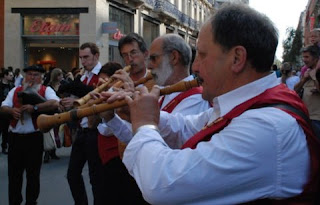




We woke to a gloriously sunny, cold and crystal-clear Autumn day. The outside temperature was a chilly 1°C but the frost-covered view from Henrietta was even prettier than yesterday. I walked to the typically French Boulangerie (I had to remind myself that we were still in Switzerland) that was open from 06:30 to 17:30 even though it was a Sunday but decided to do a quick tour of the town before I bought the bread. The views from the hill were magnificent, even clearer than yesterday. From the panorama point near the castle, I was able to see Mont Blanc that had been obscured by cloud yesterday. On the way I had passed a man sketching the château and I met him again at the panorama. He observed that we were on the same mission – he was sketching the same views that I was photographing. We had quite a long chat and he told me that a famous artist had said that the view from Romont was the finest in the world. Although that might have been an exaggeration, it was a fantastic view and with the snow on the mountains, we saw it at its best. I returned to the bakery and bought bread and two croissant.
The journey into France was sensational. The views of the Fribourgeois Prealps and the Alps were spectacular – snow-covered peaks with green grass and trees in the foreground. Where I could, I stopped to admire the views and take pictures. Fortunately, we were travelling on the byroads and we would have missed so much if we had used the motorway.
We descended to Montreux on Lake Geneva with lovely views of the lake and the surrounding mountains and then had a brief brief stop at the very picturesque Chillon Castle. We then climbed up to the Morgin pass (1370m) between Switzerland and France and stopped on the Swiss side for a picnic lunch with views of the mountains and the sunshine warm enough to sit outside. It was only a short distance to our destination, La Chapelle d'Abondnce but we had to climb to the snow line and then down into the Abondance valley. We found the car park by the church, parked up and plugged into the free electricity. The car park also has a toilet and there are a number of water taps, although they weren't working, perhaps because Winter was approaching.
We took a walk down to the river and one of the ski-lifts where we found more parking places that would have been suitable for an overnight stay – quieter than the church car park, which is close to the road, but without electricity and the WC. We decided to stay where we were..
We went for another walk to the other end of the town and found ourselves at the bar and micro brewery. From 18:00 to 19:00 is their 'happy hour' when you get two for the price of one. We sampled their wares, trying the bitter (not very good) and the blanche (wheat beer – very good). Walking back into the centre of the village we stopped at the Les Cornettes restaurant. Two years ago, we rented a chalet from our friends Alan and Inga and spent a week in La Chapelle with more friends - Ann and Nick. Alan had recommended this restaurant to us and we had a few meals there during our holiday. The meal tonight was as good as our previous experiences. I had the cold cured meats as a starter and the only problem with it was its size. There was a selection of six different meats served with a salad, a huge dish of pickled vegetables and a small dish of special pickles including tiny mushrooms and cherries. I have only ever seen pickled cherries at this restaurant and, although they sound rather peculiar, they are delicious. Bread was also provided complete with about half a pound of butter. I couldn't possibly eat all of the meat, even though Jane helped me out by eating a few slices and it was a struggle to get through the rest of the meal. Next came sliced duck breast with a green pepper sauce, beautifully cooked and served with lovely vegetables. This was followed by a huge selection of cheeses of which I had very small pieces of three local cheeses – Abondance (famous throughout France), Thom and a chevre (goats cheese). There was a choice of 26 deserts and I wasn't able to finish the sorbet, ice cream and cream with cassis, even though it was delicious.
After that, I waddled slowly back to Henrietta.
Photos: This view of Chatel St. Denis was typical of our journey to La Chapelle d'Abondance; The lovely Cillon Castle on Lake Geneva; The view from our picnic site in the Morgin Pass; The camperstop in La Chapelle d'Abondance with the backdrop of the snow-sprinkled mountains; The micro brewery in La Chapelle.


















































